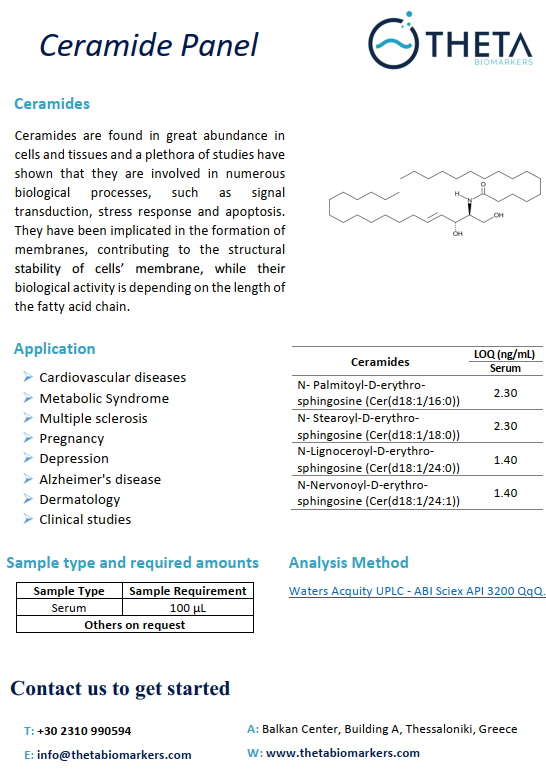Ceramide Profile
Ceramides belong to a large class of bioactive sphingolipids consisting of a long chain sphingosine base and a fatty acid. They are found in both cells and tissues and a plethora of research studies have demonstrated that they are involved in the formation of cell’s membranes, contributing to their structural stability, as well as in various biological processes, such as signal transduction, stress response and apoptosis.
The last years the key-role in human health of Ceramides is recognised, and their levels in blood circulation are linked to different disease, such as type II diabetes, cardiovascular diseases, ovarian cancer, multiple sclerosis, and other disorders (Begou et al.).
Applications
Heart attack risk assessment within 1 to 5 years!
A new ThetaBiomarkers blood analysis test can predict cardiovascular events in patients with coronary heart disease.
This analysis can help clinicians and cardiologists identify people who are at risk of cardiovascular events. The analysis includes the concentration measurement of plasma ceramides, acylcarnitines and fatty acids.
Machine learning algorithm can predict risk of myocardial infarction, acute coronary syndrome and mortality.
Available Tests
Ceramides analysis in plasma/serum
Related Articles
Development and validation of a RPLC-MS/MS method for the quantification of ceramides in human serum, Begou O.A. et al.
Serum ceramides as prognostic biomarkers of large thrombus burden in patients with stemi: A micro-computed tomography study, Karagiannidis E. et al.
Prognostic significance of metabolomic biomarkers in patients with diabetes mellitus and coronary artery disease, Karagiannidis E. et al.
Ceramides biomarkers determination in quantitative dried blood spots by UHPLC-MS/MS, Meikopoulos T. et al.
Lab Report Writing – an Introduction
Lorem ipsum dolor sit amet, consectetur adipisicing elit, sed do eiusmod tempor incididunt ut labore et dolore magna aliqua. Ut enim ad minim veniam, quis nostrud exercitation ullamco laboris nisi ut aliquip ex ea commodo consequat duis aute irure dolor in
Where can I go to provide a sample for testing?
Our country possesses approximately 170 billion barrels of oil that can be recovered with today’s technology. Of that number, 165 billion barrels are located in the oil sands.
What happens to my sample once I have provided it?
Our country possesses approximately 170 billion barrels of oil that can be recovered with today’s technology. Of that number, 165 billion barrels are located in the oil sands.
How long does testing typically take before results are available?
Our country possesses approximately 170 billion barrels of oil that can be recovered with today’s technology. Of that number, 165 billion barrels are located in the oil sands.
What will laboratory testing cost me?
Our country possesses approximately 170 billion barrels of oil that can be recovered with today’s technology. Of that number, 165 billion barrels are located in the oil sands.

